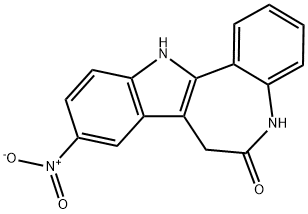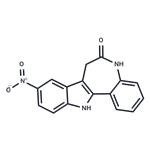Description
Alsterpaullone (237430-03-4) is a potent and selective inhibitor of GSK-3β and CDK5/p25. Potent inhibitor of CDK1/cyclin B (IC50 = 35 nM).1?Alsterpaullone induces apoptosis2 and inhibits angiogenesis3.
Uses
Alsterpaullone is a derivative of kenpaullone , an ATP-competitive inhibitor of several cyclin-dependent kinases (CDKs) as well as glycogen synthase kinase 3β (GSK3β). With slightly improved potency over kenpaullone, alsterpaullone selectively inhibits Cdk1/cyclin B, Cdk2/cyclin A, Cdk2/cyclin E, Cdk5/p25, and GSK3α/β with IC50 values of 35, 15, 200, 40, and 4 nM, respectively. Alsterpaullone has been used to inhibit the cytosolic degradation of β-catenin to alter the canonical Wnt signaling pathway in primary axis patterning, to reduce tau phosphorylation in an effort to modify neuropathological events associated with Alzheimer’s disease, and to alter cell proliferation or protein expression in various diseases.
Uses
Alsterpaullone has been used to stabilize β-catenin.
Uses
Alsterpaullone is a potent glycogen synthase kinase-3 inhibitor and a potential therapeutic agents for treatment of Parkinson disease.
Definition
ChEBI: Alsterpaullone is an organic heterotetracyclic compound that is 1,3-dihydro-2H-1-benzazepin-2-one which shares its 4-5 bond with the 3-2 bond of 5-nitro-1H-indole. It has a role as an EC 2.7.11.22 (cyclin-dependent kinase) inhibitor, an EC 2.7.11.1 (non-specific serine/threonine protein kinase) inhibitor, an EC 2.7.11.26 (tau-protein kinase) inhibitor, an antineoplastic agent, an apoptosis inducer and an anti-HIV-1 agent. It is a C-nitro compound, an organic heterotetracyclic compound and a member of caprolactams. It derives from a paullone.
Biochem/physiol Actions
Alsterpaullone (ALP) is a cyclin-dependent kinase (CDK) inhibitor. It is considered as a therapeutic agent for group 3 medulloblastomas. Alsterpaullone modulates the progression of cell cycle.?It can arrest cell cycle and stimulate the apoptosis of cancer cells by activating caspase-9 through perturbation of mitochondrial membrane potential.
References
1) Bain et al. (2003), The specificities of protein kinase inhibitors: an update; Biochem. J., 371 199
2) Lahusen et al. (2003), Alsterpaullone, a novel cyclin-dependent kinase inhibitor, induces apoptosis by activation of caspase-9 due to perturbation in mitochondrial membrane potential; Mol. Carcinog., 36 183
3) Zahler et al. (2010), Anti-angiogenic potential of small molecular inhibitors of cyclin dependent kinases in vitro; Angiogenesis, 13 239


